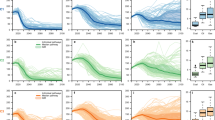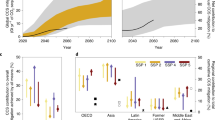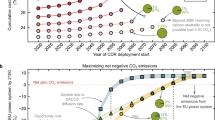Abstract
Anthropogenic energy-related CO2 emissions are higher than ever. With new fossil-fuel power plants, growing energy-intensive industries and new sources of fossil fuels in development, further emissions increase seems inevitable. The rapid application of carbon capture and storage is a much heralded means to tackle emissions from both existing and future sources. However, despite extensive and successful research and development, progress in deploying carbon capture and storage has stalled. No fossil-fuel power plants, the greatest source of CO2 emissions, are using carbon capture and storage, and publicly supported demonstration programmes are struggling to deliver actual projects. Yet, carbon capture and storage remains a core component of national and global emissions-reduction scenarios. Governments have to either increase commitment to carbon capture and storage through much more active market support and emissions regulation, or accept its failure and recognize that continued expansion of power generation from burning fossil fuels is a severe threat to attaining objectives in mitigating climate change.
This is a preview of subscription content, access via your institution
Access options
Subscribe to this journal
Receive 12 print issues and online access
$209.00 per year
only $17.42 per issue
Buy this article
- Purchase on Springer Link
- Instant access to full article PDF
Prices may be subject to local taxes which are calculated during checkout



Similar content being viewed by others
References
World Energy Outlook 2011 (IEA, 2011); available at http://www.worldenergyoutlook.org
Technology Roadmap: Carbon Capture and Storage (IEA, 2009).
Statistical Review of World Energy 2011 (BP, 2011).
Calvin, K. et al. 2.6: Limiting climate change to 450 ppm CO2 equivalent in the 21st century. Energy Econ. 31(Supplement 2), S107–S120 (2009).
IPCC Special Report on Carbon Dioxide Capture and Storage (Cambridge Univ. Press, 2005).
The Costs of CO2 Capture, Transport and Storage (ZEP, 2011).
Gibbins, J. et al. Retrofitting CO2 Capture to Existing Power Plants (IEAGHG, 2011).
Markusson, N. & Haszeldine, R. S. 'Capture ready' regulation of fossil fuel power plants — Betting the UK's carbon emissions on promises of future technology. Energy Policy 38, 6695–6702 (2010).
CCS readiness at Šoštanj: Ticking boxes or preparing for the future? (Bellona, 2011); available via http://go.nature.com/QAwjX2
Rubin, E. S. & Zhai, H. The cost of carbon capture and storage for natural gas combined cycle power plants. Environ. Sci. Technol. 46, 3076–3084 (2012).
Cost and Performance Baseline for Fossil Energy Plants, Volume 1: Bituminous Coal and Natural Gas to Electrcity (NETL, 2010).
Improvement in Power Generation with Post-Combustion Capture of CO2 (IEAGHG, 2004).
Usher, W. & Strachan, N. UK MARKAL Modelling — Examining Decarbonisation Pathways in the 2020s on the Way to Meeting the 2050 Emissions Target Final Report for the Committee on Climate Change (UCL Energy Institute, 2010); available via http://go.nature.com/qUggts
Chalmers, H., Gibbins, J. & Leach, M. Valuing power plant flexibility with CCS: the case of post-combustion capture retrofits. Mitig. Adapt. Strat. Glob. Change 17, 621–649 (2012).
Feasibility study for Europe-wide CO2 infrastructures (ARUP & SCCS, 2010); available via http://go.nature.com/aCBDnf
Haszeldine, R. S. Carbon capture and storage: How green can black be? Science 325, 1647–1652 (2009).
Progressing Scotland's CO2 Storage Opportunities (SCCS, 2011).
Thibeau, S. & Mucha, V. Have we overestimated saline aquifer CO2 storage capacities? Oil Gas Sci. Technol. 66, 81–92 (2011).
Cavanagh, A. & Wildgust, N. Pressurization and brine displacement issues for deep saline formation CO2 storage. Energy Procedia 4, 4814–4821 (2011).
Ehlig-Economides, C. & Economides, M. J. Sequestering carbon dioxide in a closed underground volume. J. Petrol. Sci. Eng. 70, 123–130 (2010).
Cavanagh, A. J., Haszeldine, R. S. & Blunt, M. J. Open or closed? A discussion of the mistaken assumptions in the Economides pressure analysis of carbon sequestration. J. Petrol. Sci. Eng. 74, 107–110 (2010).
Ehlig-Economides, C. A. & Economides, M. J. Reply to: Open or closed? A discussion of the mistaken assumptions in the Economides analysis of carbon sequestration. J. Petrol. Sci. Eng. 74, 111–112 (2010).
Zhou, Q., Birkholzer, J. T., Tsang, C-F. & Rutqvist, J. A method for quick assessment of CO2 storage capacity in closed and semi-closed saline formations. Int. J. Greenh. Gas Con. 2, 626–639 (2008).
Le Gallo, Y. Post-closure migration for CO2 geological storage and regional pressure inferences. Energy Procedia 1, 3259–3266 (2009).
Bailey, W. et al. Water control. Oilfield Rev. 12, 30–51 (2000).
Rae, M. & Helgesen, O. K. Snøhvit-CO2 sprenger reservoaret. Tesnik Ukerblad (19 May 2011); available at http://www.tu.no/olje-gass/article286534.ece
Hosa, A., Esentia, M., Stewart, J. & Haszeldine, S. Injection of CO2 into saline formations: Benchmarking worldwide projects. Chem. Eng. Res. Des. 89, 1855–1864 (2011).
Smith, M., Campbell, D., Mackay, E. & Polson, D. CO2 Aquifer Storage Site Evaluation and Monitoring (CASSEM, 2011).
Watson, J. et al. Carbon Capture and Storage: Realising the potential? (UKERC, 2012).
Chalmers, H. & Gibbins, J. Carbon capture and storage: More energy or less carbon? J. Renew. Sustain. Energy 2, 031006 (2010).
Rutherford, A. (ed.) Global CCS Projects Map (SCCS,2012); available at http://www.sccs.org.uk/map.html
The Global Status of CCS (Global Carbon Carbon Capture and Storage Institute, 2011); available via http://go.nature.com/HHblMC
G8 Hokkaido Toyako Summit Leaders Declaration (G8, 2008); available via http://go.nature.com/l8fs4j
Meadowcroft, J. & Langhelle, O. in Caching the Carbon: The Politics and Policy of Carbon Capture and Storage (eds Meadowcroft, J. & Langhelle, O.) 267–296 (Edward Elgar, 2009).
Pollak, M. F., Johnson, J. A. & Wilson, E. J. The geography of CCS regulatory development in the U.S. Energy Procedia 1, 4543–4550 (2009).
Pollak, M., Phillips, S. J. & Vajjhala, S. Carbon capture and storage policy in the United States: A new coalition endeavors to change existing policy. Glob. Environ. Change 21, 313–323 (2011).
Energy Technology Perspectives 2012 (IEA, 2012).
Fairley, P. Cleaner Coal Faces an Uncertain Future (MIT Technology Review, 2011); available via http://go.nature.com/2ISVzd
Von Stechow, C., Watson, J. & Praetorius, B. Policy incentives for carbon capture and storage technologies in Europe: A qualitative multi-criteria analysis. Glob. Environ. Change 21, 346–357 (2011).
Energy Roadmap 2050 (EU, 2011); available via http://go.nature.com/drHaGh
Roberts, J. J., Wood, R. A. & Haszeldine, R. S. Assessing the health risks of natural CO2 seeps in Italy. Proc. Natl Acad. Sci. 108, 16545–16548 (2011).
Stone, E. J., Lowe, J. A. & Shine, K. P. The impact of carbon capture and storage on climate. Energy Environ. Sci. 2, 81–91 (2009).
Gerlagh, R. & van der Zwaan, B. Evaluating uncertain CO2 abatement over the very long term. Environ. Model. Assess. 17, 1–12 (2011).
Tollefson, J. Low-cost carbon-capture project sparks interest. Nature 469, 276–277 (2011).
United Nations Climate Change Secretariat Durban Conference Delivers Breakthrough in International Community's Response to Climate Change (UNFCCC, 2011); available via http://go.nature.com/4DFLUT
De Conick, H., Stephens, J. C. & Metz, B. Global learning on carbon capture and storage: A call for strong international cooperation on CCS demonstration. Energy Policy 37, 2161–2165 (2009).
Markusson, N., Shackley, S. & Evar, B. The Social Dynamics of Carbon Capture and Storage (Routledge, 2012).
Rai, V., Victor, D. G. & Thurber, M. C. Carbon capture and storage at scale: Lessons from the growth of analogous energy technologies. Energy Policy 38, 4089–4098 (2010).
Seligsohn, D., Liu, Y., Forbes, S., Dongjie, Z. & West, L. CCS in China: Toward an Environmental, Health, and Safety Regulatory Framework (WRI, 2010).
Acknowledgements
We acknowledge support from Scottish Funding Council (V.S., R.S.H), UK Natural Environment Research Council (S.G.), UK Energy Research Centre (N.M.). We thank colleagues at the Scottish Carbon Capture and Storage centre www.sccs.org.uk for discussions and suggestions.
Author information
Authors and Affiliations
Corresponding author
Rights and permissions
About this article
Cite this article
Scott, V., Gilfillan, S., Markusson, N. et al. Last chance for carbon capture and storage. Nature Clim Change 3, 105–111 (2013). https://doi.org/10.1038/nclimate1695
Received:
Accepted:
Published:
Issue Date:
DOI: https://doi.org/10.1038/nclimate1695
This article is cited by
-
Potential of land-based climate change mitigation strategies on abandoned cropland
Communications Earth & Environment (2023)
-
Reduction potential of the energy penalty for CO2 capture in CCS
Frontiers in Energy (2023)
-
Plant conversions and abatement technologies cannot prevent stranding of power plant assets in 2 °C scenarios
Nature Communications (2022)
-
Amine-based capture of CO2 for utilization and storage
Polymer Journal (2021)
-
Impact of declining renewable energy costs on electrification in low-emission scenarios
Nature Energy (2021)



